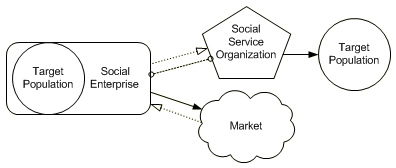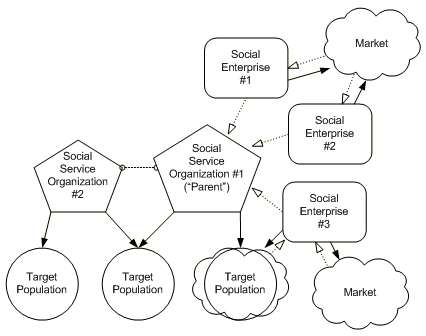Social enterprises combine operational models to capture opportunities in both commercial markets and social sectors. Combining is a strategy to maximize social impact as well as diversify income by reaching new markets or creating new enterprises. In practice, most experienced social enterprises combine models--few social enterprise operational models exist in their pure form. Operational models are like building blocks that can be arranged to best achieve an organization’s financial and social objectives.
Model combinations occur within a social enterprise (Complex Model) or at the level of the parent organization (Mixed Model).
Social enterprise models are combined to:
- facilitate enterprise or social program growth;
- increase revenues by entering new markets or businesses;
- augment breath or depth of social impact by reaching more people in need or new target populations.

 A complex model of social enterprise combines two or more operational models. Complex models are flexible; virtually any number or type of operational models can be combined into one social enterprise.
A complex model of social enterprise combines two or more operational models. Complex models are flexible; virtually any number or type of operational models can be combined into one social enterprise.  Many nonprofit organizations run multi-unit (mixed) operations, each with different social programs, financial objectives, market opportunities and funding structures. Each unit within the mixed model may be related vis-à-vis target population, social sector, mission, markets, or core competencies. A museum for example, in addition to educational art exhibits, might have both a for-profit catalogue business and highly subsidized research and acquisition operation.
Many nonprofit organizations run multi-unit (mixed) operations, each with different social programs, financial objectives, market opportunities and funding structures. Each unit within the mixed model may be related vis-à-vis target population, social sector, mission, markets, or core competencies. A museum for example, in addition to educational art exhibits, might have both a for-profit catalogue business and highly subsidized research and acquisition operation.